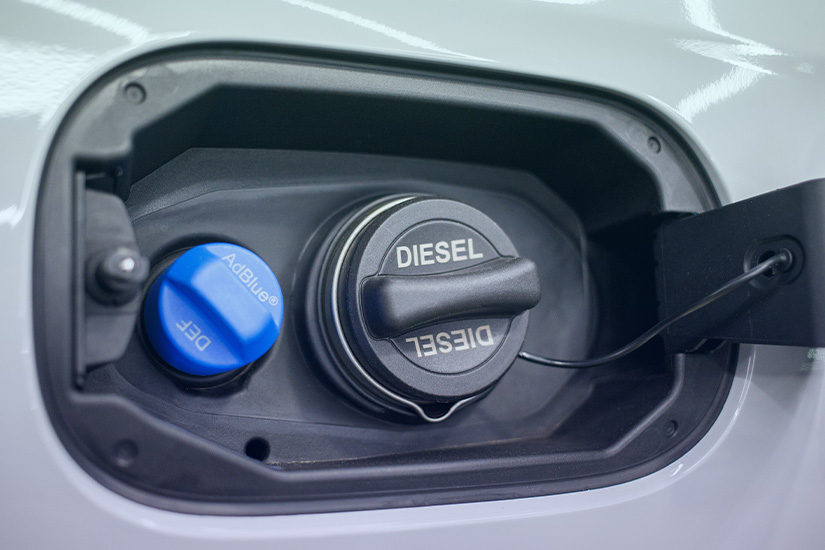S h a r e
The dos and don’ts of using AdBlue


Posted by
Martin Brown
February 2025
What is Adblue? And why do you need it for your diesel car?
If you’ve not come across it before, it’s an additive that is used to help diesel cars run cleaner exhaust emission systems. Not all diesel cars require AdBlue, however.
Now, while it’s true that demand for diesel cars is declining – the Society of Motor Manufacturers and Traders (SMMT) reports that in the first six months of 2024, registrations of new diesels were down 12.1% on the previous year – many drivers still enjoy the fuel economy, big ranges and the towing pulling power of diesel-engined vehicles.
While the choice of diesel cars has reduced (diesel in small cars was dropped some time ago) at least 15 brands still offer them, including Audi, BMW, Land Rover, Mercedes and Volkswagen.
If you’re a company car driver, the chances are that your next new car will be electric, which apart from the environmental benefit carries huge tax benefits. However, for some fleets, diesel cars still provide the most effective means of transport for employees. It is also possible that your company is in the process of transitioning to electric cars, so diesel vehicles may still be offered on the choice list and may be more appropriate than an electric car.
AdBlue is needed to meet Euro 6 and future Euro 7 emissions
Today’s diesel cars are as ‘clean’ as they have ever been, thanks to highly sophisticated emissions technology. From September 2015 they became subject to the Euro 6 emissions regulations which were introduced to target a host of harmful gases linked to respiratory disease, especially nitrogen oxides (NOx) in urban areas. Euro 6 cut the permissible diesel limits for NOx from 180mg/km to 80mg/km. For petrol this was 60.
To meet Euro 6 and beyond, many new diesel cars now have a Selective Catalytic Reduction system which involves the injection of a Diesel Exhaust Fluid (DEF) which assists in the breakdown of NOx (HGVs have to have SCR by law). This DEF is commonly known as AdBlue, a German trademarked name which has become a generic term (sometimes also called Bluedef, or BlueTec). AdBlue is a high purity synthetic urea mixed with de-ionised water, ideally in a 32.5%/67.5% proportion. And it isn’t actually blue, but transparent.
A close-coupled SCR catalyst is located between the turbocharger and the diesel oxidation catalytic converter. AdBlue is injected into the exhaust gas upstream of the converter (roughly 5% in proportion to diesel). Some SCR systems have two catalysts, a smaller one for the cold start phase. The chemical reaction created by the ammonia in the urea converts harmful gases into nitrogen, steam and CO2.
The global integrated energy company, Total Energies, says that AdBlue and SCR systems reduce NOx emissions by up to 90%, hydrocarbon and carbon monoxide emissions by 50-90%, and particulate emissions by 30-50%. In 2025, under the expected Euro 7 regulations, diesels will have to meet the petrol 60mg/km target for NOx.
How do I know if I have an AdBlue diesel?
If you are given a new or recent diesel as your company car, it’s highly likely to have an AdBlue system. Your fleet manager should guide you through, but the easiest check is to:
- Open the fuel filler flap
- Check if there is a smaller filler with a blue cap below the filler for diesel.
However, some diesel cars have an AdBlue tank in the boot, usually in the spare wheel well (on a Range Rover it’s in the front wing). A look in the handbook will provide all the info you need.
How much AdBlue gets used and how is it monitored?
How much AdBlue you use will depend on how many miles you cover and at what speed. But on average, reckon on using up to 1.5-litres every 620 miles (1,000kms), so topping up every 5,000 to 8,000 miles.
The larger the car the larger the AdBlue tank. For example, the compact Volkswagen Tiguan SUV holds 12 litres; the largest Touareg SUV 19.5 litres. Like all cars with an SCR system, a dashboard display will give you plenty of warning of low AdBlue – in Volkswagen cars the first message is displayed when the remaining range is approximately 1,500 miles, repeated every 62 miles until the range reaches 1,000 miles, then every 31 miles. If you run it down to the red, once the ignition is turned off, the car won’t start again until the system is refilled (the dashboard indicator will show the level). There will be a minimum level before the car will restart; in the case of Audis it is 5.7 litres.
How do I top up with Adblue?
AdBlue is considered a consumable similar to fuel, so it’s the driver’s responsibility to ensure the tank is kept topped up and to pay any costs associated with doing so. However, for those who do a low mileage, AdBlue may simply be added at service time.
The principle is very similar to topping up with screen wash:
- At some point you’ll have to buy some fluid and do it yourself
- It’s sold at filling stations, dealerships and supermarkets
- 10 litres is the most common container – as of mid-2024 a 10-litre container of Halfords AdBlue cost £16.99
- The containers usually come with a nozzle for filling up
AdBlue is not toxic, but it can corrode some materials, so is best kept at home for when you need it. It also has a shelf life and should be used soon after the cap is opened. The general advice is to use as much of the contents as possible once opened.
What if you accidentally put AdBlue in the diesel tank?
If you have a diesel car with an AdBlue filler below the diesel tank filler, it is possible you could accidentally put the wrong fluid into either filler.
Like putting diesel into a petrol car and vice-versa, adding AdBlue to the diesel tank, or diesel to the AdBlue tank, can have catastrophic consequences for the engine and fuel/AdBlue system. Either scenario will set off a chemical reaction and pollute the tank.
The golden rule is not to start the engine – or even risk it by putting the key in the ignition. Call a breakdown recovery service immediately or a mobile fuel technician (search for ‘wrong fuel’ or ‘fuel technician’) who will either transport the car to a garage or drain and cleanse the system where you are.
You also might like…
If you liked this article then check out our posts about similar topics
Outsourcing Your Fleet: 10 Reasons Fleet Alliance Makes Perfect Sense for Busy Fleet Managers
Running a large corporate fleet means you’re under constant pressure to hit cost, compliance, and sustainability targe...
What makes Fleet Alliance a winner in the SME fleet sector?
We all like an award, an additional trophy for the cabinet - the recognition is important and it’s always good to rece...
10 great cars to have on salary sacrifice 2025
Employers and employees are really catching on to salary sacrifice because you can drive a brand new electric car (EV) a...
How changes to the ZEV mandate can help on the decarbonisation journey
With media headlines stuffed full of tariffs and their impacts on the UK and the world economy, it is perhaps little won...
Is an electric car on salary sacrifice too good to be true?
Short answer: no But you probably want something more reassuring than that So let’s go If you were to lease an e...
Changes to Vehicle Excise Duty and the Luxury Car Tax for electric cars
Electric car (EV) customers need to be aware of two important changes to Vehicle Excise Duty (VED) - more commonly known...
An opportunity for fleets to electrify vans
Cars have been the easy part of fleet decarbonisation Conducive benefit-in-kind taxation has persuaded company car drive...
Volvo ES90 Review: The Future of Electric Luxury
The electric revolution shows no sign of slowing, and Volvo is making its next decisive move with the all-new ES90 – a...
Ready to make the management of your fleet more efficient?
Request a call back
